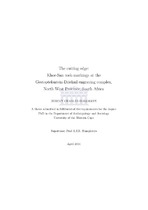| dc.description.abstract | The study is about the rock engravings on the wonderstone hills just outside Ottosdal, North West province, about 70km northwest of Klerksdorp. Wonderstone is remarkable rock that is smooth, shiny and very easy to mark. The wonderstone occurs only on two adjacent farms, Gestoptefontein and Driekuil, and thus the rock art on the wonderstone outcrops is referred to as the Gestoptefontein- Driekuil complex (GDC). This rock art is now the only remaining trace of what must once have been a much larger complex of engravings. Sadly, much of the rock art has been destroyed in the course of mining activities, with very few records. The largest remaining outcrop is still threatened by potential mining activities. The study attempts to bring this disastrous and unacceptable situation to the attention of the public and the heritage authorities, who have so far failed to respond to applications to grant the sites protection. It therefore has two main aims: to locate and record as much of the rock art as possible and to understand the significance of the outcrops in the lives of the people who made them. Based on the rock art itself, as well as what little historical evidence is available, it is argued that the rock art was made by Khoe-San people during the performance of important ceremonies and other activities. The rock art has two main components: engravings of referential motifs and a gestural, or performative, element. The referential motifs depict a range of things: anthropomorphs and zoomorphs, decorative designs, items of clothing, as well as ornaments and decorations. The gestural markings were made by rubbing, cutting and hammering the soft wonderstone, probably in the course of a range of activities that people carried out on the outcrops. One of the main findings of the study is that the GDC was a place that was of particular significance to women. This is suggested by the large number of engravings of items that are closely associated with Khoe-San women – depictions of aprons, ornaments, and decorations. These play a prominent role in the initiation practices of many Khoe-San groups. Initiates emerging from ritual isolation after their first menstruation are given new clothes; they are also loaned ornaments and jewellery. This reincorporation into society as a ‘new person’ has been described by some Khoe-San women as one of the high points of their lives. Oral traditions from the area indicate that the wonderstone outcrops were believed to have special properties; the study incorporates these traditions to argue that the wonderstone outcrops were associated with the presence of a great water snake that lay on the rocks and also lived in the pools of water in the nearby Driekuil Spruit. People therefore came to the outcrops to perform rites of reincorporation. One of these ceremonies may have been performing rites of association with the great snake; such practices may have included the use of rock dust as an ingredient for body paint. | en_US |

